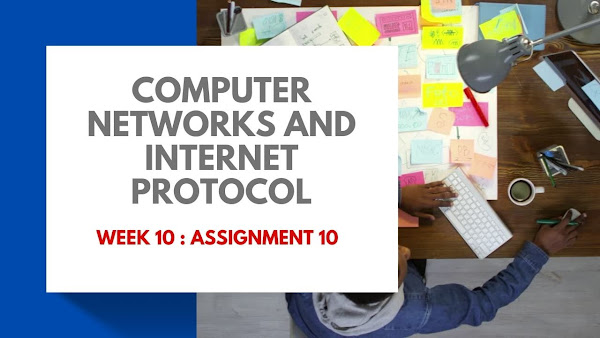Computer Networks And Internet Protocol - Week 10 | Assignment : Answer with Explanation
MAC protocols enable two nodes using their separate communication resources to establish, maintain and terminate a connection.
a. Trueb. False
Answer
a. True
Which is NOT one of the LLC services?
a.Connection mode serviceb. Acknowledged connectionless service
c. Intermediate switching service
d. Unacknowledged connectionless service
Answer
c. Intermediate switching service
The connection mode service provides a reliable, connection-oriented service that uses error control and flow control mechanisms to ensure reliable data delivery. The acknowledged connectionless service provides a reliable, connectionless service that uses error control mechanisms to ensure reliable data delivery. The unacknowledged connectionless service provides an unreliable, connectionless service that does not use error control mechanisms.
Support by Installing and Using "Computer Courses - All in One" Free android app
Which of the following are correct about Asynchronous MAC techniques? (i) Reservation method is suited for streaming voice traffic. (ii) Contention method is suitable for continuous traffic.
a. only (i)b. only (ii)
c. both (i) and (ii)
d. None
Answer
a. only (i)
Reservation
– For stream traffic (voice ,bulk file transfer)
– Time on the medium is divided into slots, like synchronous TDM
– A station whishing to transmit reserves slots for an extended period
Con t e n t i on
– For bursty traffic (short, sporadic transmissions such as interactive terminal-host traffic)
– No control is exercised to determine whose turn it is
– Simple to implement and efficient for light loads
Which of the following is true about CSMA/CD?
(i) When a collision is detected, the source backs off for a fixed amount of time
before retrying for packet transmission.
(ii) The worst case delay to detect a collision is equal to the end-to-end propagation
delay.
a. only (i)b. only (ii)
c. both (i) and (ii)
d. None
Answer
d. None
In CSMA/CD (Carrier Sense Multiple Access with Collision Detection), when a collision is detected, the station stops transmitting that frame, transmits a jam signal, and then waits for a random time interval before trying to resend the frame 1. The worst case delay to detect a collision is equal to twice the end-to-end propagation delay 2.
Every station connected to an Ethernet network is provided a 6-byte physical address by
a. the firmwareb. the network interface card
c. the internet service provider
d. None of this
Answer
c. the internet service provider
Every station connected to an Ethernet network is provided a 6-byte physical address by the network interface card (NIC). This address is also known as the MAC (Media Access Control) address.
NIC fits inside the station and provides the station with a 6-byte physical address.
All assignment and solution: Computer Networks And Internet Protocol | NPTEL
The T in 10baseT and 100baseT Ethernet technology stands for
a. Transmissionb. Twisted Pair
c. Total utilization
d. Top Speed
Answer
b. Twisted Pair
The “T” in 10baseT and 100baseT Ethernet technology stands for “Twisted Pair,” which refers to the type of cabling used in these networks.
Which of the following is/are true?
a. In full-duplex switched Ethernet, there is no need for the CSMA/CD method.b. Ethernet is best utilized when the load is heavy.
c. Slotted ALOHA has lower maximum utilization compared to pure ALOHA.
d. Random backoff in CSMA/CD makes it less probable that sources would try to retransmit in lockstep after a collision is detected.
Answer
a. In full-duplex switched Ethernet, there is no need for the CSMA/CD method.
d. Random backoff in CSMA/CD makes it less probable that sources would try to
retransmit in lockstep after a collision is detected.
Ethernet is work best under light load.
In full-duplex switched Ethernet, there is no need for the CSMA/CD method. In a full-duplex switched Ethernet, each station is connected to the switch via two separate links.
Each station or switch can send and receive independently without worrying about collision. Each link is a point-to-point dedicated path between the station and the switch. MAC layer becomes much simpler.
In CSMA/CD (Carrier Sense Multiple Access with Collision Detection), a random backoff algorithm is used to schedule re-transmissions after collisions. This algorithm is generally used in Ethernet to schedule re-transmissions after collisions. The random wait time after collision in CSMA/CD is generated using a rule called binary exponential backoff. The purpose of this algorithm is to make it less probable that sources would try to retransmit in lockstep after a collision is detected
In Go-Back-N ARQ, if the sequence number is represented by 4 bits, the sender and receiver window size should be,
a.16, 16b.8,1
c. 15,15
d.15,1
Answer
d.15,1
windows size = 2^m-1, receiver window size is always 1.
When an acknowledgement is lost duging Go-Back-N ARQ, the receiver retransmits the acknowledgement after a timeout.
a. Trueb. False
Answer
b. False
According to IEEE 802.3, for collision detection the maximum distance between hosts must be within.
a. 500mb. 1500m
c. 2500m
d. 2000m
Answer
a. 500m
10BASE5: Thick wire coaxial cable with a maximum cabling length of 500 meters.
Disclaimer:
"This page contains multiple choice questions (MCQs) related to Computer Networks and Internet Protocols. The answers to these questions are provided for educational and informational purposes only.These answers are provided only for the purpose to help students to take references. This website does not claim any surety of 100% correct answers. So, this website urges you to complete your assignment yourself."




0 Comments